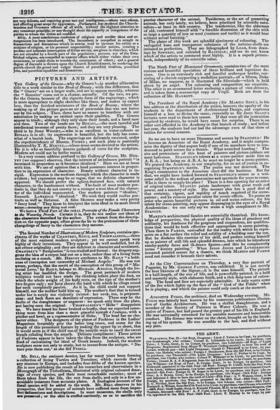PICTVRES AND ARTISTS.
THE Gallery of the Graces—why the Graces ?—is another alliterative title to a work similar to the Book of Beauty ; witlethis difference, that the "' Graces" are on a larger scale, and are to appeartnonthly, whereas the " Beauties" come out in a cluster, annually. Of the two, we pre- fer the Graces, because of the vignette form of the engravings ; which is more appropriate to slight sketches like these, and makes us expect less, than the finished miniatures of the Book Beauty; where the making up of the picture gave an air of pretension that was not borne out by the subject. , Then. these have no names to interfere with our admiration by making us critical upon their qualities. The Graces appear in triads ; although they only show their heads, and a hand now and then. Two of the. heads are by BoxAme—the most tasteful and intellectual inventor of pretty faces; and they are very pleasing. The third is by JOHN WRMHT,-.--who is as excellent in water-colours as BOxeite is in oil: its expression is beautiful, but the lady has some- what. of a boyish look. The engravings are delicately executed, under the superintendence of Messes.. Frei:PEN ; and each plate is poetically Dlustratedby K, HERVEY,—whose muse seems devoted to the artists. He it is who so fancifully. weaves garlands of verse for the sculptors. Modern art could not be better mated. In a very' ornate address. prefixed to the Gallery of Graces, Mr. HER- VEY (we suppose) observes, that the interest of an unknown portrait "is increased in proportion as it becomes idealized." Here we are at issue with him. We are of opinion that a head possesses interest in propor- tionto its expression of. character. Beauty without character is in- sipid. Expression is the medium through which the character is made evident; but expression may be so vague, that no definite character is apparent. We should prefer the ugliest-featured face, with natural character, to the handsomest without. The fault of most modern por- traits is, that they do not convey to a stranger a true idea of the charac- ter of the individual represented. Our modern painters "idealize," forsooth. LAWRENCE " We wish they would realize por- traits as well as fOrtunea. A false likeness may make a very pretty "fancy head." They ieem 'to interpret the term ideal in its most literal Sense—meaning any thing not real. We haves -Third Fart of the IDEAL Portraits of the Female Characters els the Waverky Novels.' Certain it is, they do not realize our ideas of he characters described by the author. The extract from the descrip- tion on the opposite page, often gives the lie to the pretensions of these changelings of fancy to the characters they. assume.


























 Previous page
Previous page